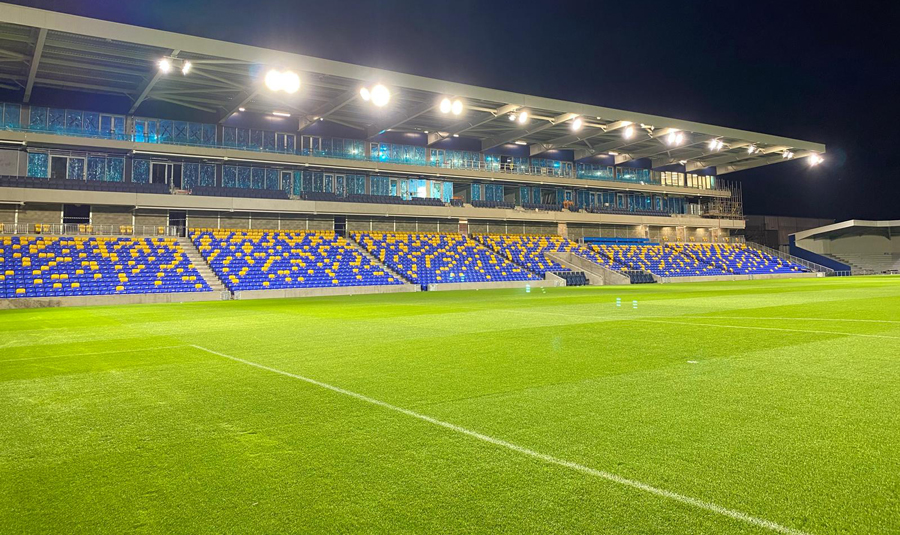Football floodlighting – don’t be left in the dark
It might only be January, but – at football clubs across Europe – thoughts will already be beginning to turn towards the end of the season. And while it might not be possible to predict exactly who’s going to win what, we can at least get a decent idea of which teams will be fighting for promotion come the spring
As exciting as that is for supporters, for clubs themselves it’s the start of what can be a long and technical journey towards the next level – one that’s often as much about what happens off of the pitch as what happens on it.
Let’s take the English football league as an example. The pyramidal structure here sees the Premier League at the top, followed by the Championship, League One, League Two, and then the National League and its numerous sub-divisions. Whenever a club gets promoted, it needs to demonstrate that its ground meets the requirements of the league it is stepping into.
These ground grading requirements cover a variety of issues, ranging from seating capacity and pitch boundaries through to the PA system and, of course, lighting. Lighting standards are critical to the modern game, not just because they create a better environment for players and supporters, but because they provide TV networks with the right visual conditions for great broadcast coverage.

The higher a club goes, the more stringent the lighting requirements become. And while the difference in what’s needed between the National League and the National League North might be relatively slight, the increase in brightness required when a club goes from the National League to League Two can be as much as 70%. That’s a considerable jump, and one that has implications that go beyond just the luminaires themselves.
Generally, there are three lighting-related issues that a club needs to consider when promotion is on the table: their existing infrastructure, their current power arrangements, and planning.
- Infrastructure
For clubs making the climb from the lower leagues, this will be one of the primary concerns. High quality football floodlighting requires a specific combination of masts and fixtures, and while clubs at certain levels will be able to reuse or upgrade their existing facilities, some will need an entirely new installation. Naturally, that has a significant impact on planning. - Power
A ground’s electricity supply can present a similar challenge to the above, albeit one that is more widely applicable. Football stadiums don’t tend to have any spare capacity when it comes to power, meaning that they use up everything they can draw down. At the same time, the increase in brightness required in the example above would also demand around 80 Amps of additional power – so clubs need to be sure that they can ramp up supply when they need it. - Planning
Any significant change to a football club’s facilities will need to be approved by the local planning authority. While this may be less of an issue for grounds that occupy a dedicated space – like many of those in the Premier League, for example – clubs situated in or near to residential areas will need to show that they’ve taken factors like light spill into account when upgrading their lighting.
So, why does all of this need to be thought about in January when most domestic leagues don’t finish until May? Primarily because all of these factors have a major impact on the timeline for a new lighting installation.
Planning alone can take as long as 16 weeks, so even if the documents were submitted on January 1st, it’s not unreasonable to assume that sign-off wouldn’t take place until around mid-April. From there, any changes to the stadium’s infrastructure could take around a month, landing us in the middle of May. With around six weeks needed to build the floodlights, and four weeks to install them, that takes us to the first weekend in August – just when many leagues will kick off once again.
Ensuring that all of the above goes as smoothly as possible is clearly vital, and it’s important for clubs to get the right support in terms of planning and design so that they can prevent any unforeseen issues from arising.
Then, of course, there are the issues of cost and efficiency; many clubs operate on extremely tight budgets, and will want to ensure that they’re getting the best possible performance at the best possible price. While any upgrade from metal halide to LED lights is likely to offer considerable reductions by default, the right expertise at the design stage can help to identify additional cost-saving opportunities.
Finally, there’s the matter of future proofing. While year-on-year promotions are admittedly rare, it does make sense to think about tomorrow’s lighting requirements when planning any upgrade – just ask Midstream Lighting customer AFC Wimbledon. It might involve a slightly higher outlay in the first instance, but a forward thinking approach to lighting can ultimately save money in the long term.
There’s a long way to go between now and May. But just as any supporter will tell you that it’s never too early to start dreaming, it’s never too early to start thinking about next season’s lighting either.

